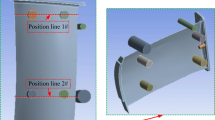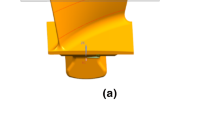Abstract
The design and manufacturing level of the blade largely affects the performance of the aero engine. In this paper, the blade is taken as the research object, focusing on its design and processing. On the one hand, based on the mathematical method of fifth-order polynomial, a GUI module for parameterized design of different blade profiles is established. On the other hand, in CAM environment, the procedure division of turn-milling the blade, the generation of tool path, the optimization of NC program and the simulation of machining process are completed. On this basis, the experiment of machining the part by turn-milling is finished. In addition, in order to study the quality of the machined surface, a mathematical model for predicting the surface topography of turn-milling blade is established based on the surface unfolding and meshing of the workpiece. Then, the effects of the number of cutter teeth, tool rotation speed, feed rate, and the cutter radius on surface topography are analyzed qualitatively. Besides, the maximum surface residual height is used as an index to quantitatively compare the influence of different parameters on surface topography. Finally, the simulation reliability is verified by comparing with the experimental surface.















Similar content being viewed by others
Abbreviations
- b :
-
Chord length (mm)
- f max :
-
Maximum deflection
- β 1k :
-
Leading edge angle (°)
- β 2k :
-
Trailing edge angle (°)
- β 1 :
-
Import (front) structural angle (°)
- β 2 :
-
Exit (trailing edge) structural angle (°)
- β m :
-
Installation angle (°)
- β o :
-
Outlet angle (°)
- τ :
-
Cascade solidity, τ = b/t
- i :
-
Attack angle, the difference between β1 and β1k. (°)
- δ :
-
Bend angle, the sum of β1k and β2k. (°)
- t :
-
Grid pitch (mm)
- r 1 :
-
Leading-edge radius (mm)
- r 2 :
-
Trailing-edge radius (mm)
- C max :
-
Maximum thickness (mm)
- φ 1 :
-
Leading edge wedge angle of inlet edge (°)
- φ 2 :
-
Leading edge wedge angle of exit edge (°)
- l :
-
Throat width (mm)
- S :
-
Axial width of blade profile (mm)
- N b :
-
Number of blades
- n t :
-
Tool rotation speed (rpm)
- n w :
-
Workpiece rotation speed (rpm)
- n w, relative :
-
Relative speed of the workpiece (rpm)
- n w, ave :
-
The average value of relative rotational speed of workpiece (rpm)
- a p :
-
Cutting depth (mm)
- R t :
-
Tool radius (mm)
- R w :
-
Workpiece radius (mm)
- ∆ϕ:
-
Instantaneous rotation angle of workpiece
- ΔW:
-
Residual height of the workpiece surface after each feed of the tool (μm)
- W :
-
Residual height of the machined surface (μm)
- R s :
-
Instantaneous radius at the edge of blade section (mm)
- c :
-
Total feed rate (mm/z)
- c a :
-
Axial feed per tooth (mm/z)
- c z :
-
Circumferential feed per tooth (mm/z)
- f a :
-
Axial feed per second (mm/s)
- N t :
-
Number of cutter teeth
References
Li J, Sun H, Wang J, Feng Z (2011) Numerical investigations on the steady and unsteady leakage flow and heat transfer characteristics of rotor blade squealer tip. J Therm Sci 20:304–311. https://doi.org/10.1007/s11630-011-0474-5
Xiao G, Huang Y (2016) Equivalent self-adaptive belt grinding for the real-R edge of an aero-engine precision-forged blade. Int J Adv Manuf Technol 83:1697–1706. https://doi.org/10.1007/s00170-015-7680-3
Öksüz O, Akmandor IS (2008) Multi-objective aerodynamic optimization of axial turbine blades using a novel multi-level genetic algorithm. Vol 6 Turbomachinery, Parts A, B, C 132:2375–2388. https://doi.org/10.1115/GT2008-50521
Liu YP, Zhao S, Dong XY (2010) Constructing section profile curve of turbine blade. Int Conf Wavelet Anal Pattern Recognition 2010:211–215. https://doi.org/10.1109/ICWAPR.2010.5576329
Alexeev RA, Tishchenko VA, Gribin VG, Gavrilov IY (2017) Turbine blade profile design method based on Bezier curves. J Phys Conf Ser 891:012254. https://doi.org/10.1088/1742-6596/891/1/012254
Fathi A, Shadaram A (2013) Multi-level multi-objective multi-point optimization system for axial flow compressor 2d blade design. Arab J Sci Eng 38:351–364. https://doi.org/10.1007/s13369-012-0435-7
Samad A, Kim KY (2008) Multi-objective optimization of an axial compressor blade. J Mech Sci Technol 22:999–1007. https://doi.org/10.1007/s12206-008-0122-5
Zhang W, Zou Z, Ye J (2012) Leading-edge redesign of a turbomachinery blade and its effect on aerodynamic performance. Appl Energy 93:655–667. https://doi.org/10.1016/j.apenergy.2011.12.091
Wan M, Gao TQ, Feng J, Zhang WH (2019) On improving chatter stability of thin-wall milling by prestressing. J Mater Process Technol 264:32–44. https://doi.org/10.1016/j.jmatprotec.2018.08.042
Zhu L, Jiang Z, Shi J, Jin C (2015) An overview of turn-milling technology. Int J Adv Manuf Technol 81:493–505. https://doi.org/10.1007/s00170-015-7187-y
Comak A, Altintas Y (2017) Mechanics of turn-milling operations. Int J Mach Tools Manuf 121:2–9. https://doi.org/10.1016/j.ijmachtools.2017.03.007
Karagüzel U, Uysal E, Budak E, Bakkal M (2015) Analytical modeling of turn-milling process geometry, kinematics and mechanics. Int J Mach Tools Manuf 91:24–33. https://doi.org/10.1016/j.ijmachtools.2014.11.014
Grigoriev SN, Kutin AA, Turkin M (2013) Advanced CNC programming methods for multi-axis precision machining. Key Eng Mater 581:478–484. https://doi.org/10.4028/www.scientific.net/KEM.581.478
Bin DX, Wan M, Yang Y, Zhang WH (2019) Efficient prediction of varying dynamic characteristics in thin-wall milling using freedom and mode reduction methods. Int J Mech Sci 150:202–216. https://doi.org/10.1016/j.ijmecsci.2018.10.009
Zhang D, Li C, Zhang Y, Jia D, Zhang X (2015) Experimental research on the energy ratio coefficient and specific grinding energy in nanoparticle jet MQL grinding. Int J Adv Manuf Technol 78:1275–1288. https://doi.org/10.1007/s00170-014-6722-6
Kundrak J, Felho C (2018) Topography of the machined surface in high performance face milling. Procedia CIRP 77:340–343. https://doi.org/10.1016/j.procir.2018.09.030
Ramana MV, Aditya YS (2017) Optimization and influence of process parameters on surface roughness in turning of titanium alloy. Mater Today Proc 4:1843–1851. https://doi.org/10.1016/j.matpr.2017.02.028
Zhu L, Jin X, Liu C (2016) Experimental investigation on 3D chip morphology properties of rotary surface during orthogonal turn-milling of aluminum alloy. Int J Adv Manuf Technol 84:1253–1268. https://doi.org/10.1007/s00170-015-7758-y
Zhu L, Li H, Wang W (2013) Research on rotary surface topography by orthogonal turn-milling. Int J Adv Manuf Technol 69:2279–2292. https://doi.org/10.1007/s00170-013-5202-8
Savas V, Ozay C (2008) The optimization of the surface roughness in the process of tangential turn-milling using genetic algorithm. Int J Adv Manuf Technol 37:335–340. https://doi.org/10.1007/s00170-007-0984-1
Jin CZ, Fang R (2014) Research on surface topography and roughness of micro parts by high speed turn-milling. Mater Sci Forum 800–801:607–612. https://doi.org/10.4028/www.scientific.net/MSF.800-801.607
Lavernhe S, Quinsat Y, Lartigue C (2010) Model for the prediction of 3D surface topography in 5-axis milling. Int J Adv Manuf Technol 51:915–924. https://doi.org/10.1007/s00170-010-2686-3
Zhu L, Liu B, Wang X, Xu Z (2016) Research on cutting force of turn-milling based on thin-walled blade. Adv Mater Sci Eng 2016:1–11. https://doi.org/10.1155/2016/2638261
Liu C, Zhu L, Ni C (2018) Chatter detection in milling process based on VMD and energy entropy. Mech Syst Signal Process 105:169–182. https://doi.org/10.1016/j.ymssp.2017.11.046
Karaguzel U, Bakkal M, Budak E (2012) Process modeling of turn-milling using analytical approach. Procedia CIRP 4:131–139. https://doi.org/10.1016/j.procir.2012.10.024
Miyazaki T, Hotta Y, Kunii J et al (2009) A review of dental CAD/CAM: current status and future perspectives from 20 years of experience. Dent Mater J 28:44–56. https://doi.org/10.4012/dmj.28.44
Magambo S, Ying L (2013) The NC Machining post-processing technology based on UG. 2:4–7. https://doi.org/10.4028/www.scientific.net/AMR.753-755.1254
Lin T, Premarathna A, Bohez ELJ (2018) Integrated approach for milling impeller parts. Comput Aided Des Appl 15:180–187. https://doi.org/10.1080/16864360.2017.1375667
Zhang W-H, Tan G, Wan M, Gao T, Bassir DH (2008) A new algorithm for the numerical simulation of machined surface topography in multiaxis ball-end milling. J Manuf Sci Eng 130:011003. https://doi.org/10.1115/1.2815337
Funding
This work was supported by the National Natural Science Foundation of China (NSFC; 51475087).
Author information
Authors and Affiliations
Corresponding author
Additional information
Publisher’s note
Springer Nature remains neutral with regard to jurisdictional claims in published maps and institutional affiliations.
Rights and permissions
About this article
Cite this article
Ning, J., Zhu, L. Parametric design and surface topography analysis of turbine blade processing by turn-milling based on CAM. Int J Adv Manuf Technol 104, 3977–3990 (2019). https://doi.org/10.1007/s00170-019-04037-x
Received:
Accepted:
Published:
Issue Date:
DOI: https://doi.org/10.1007/s00170-019-04037-x




